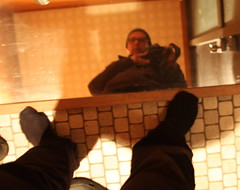March 04, 2011
Susano, Amaterasu and the Stranger in the Mirror
I did not put the camera a quite the same position as my eyes, so the camera see slightly less of my legs, but if you look down into a mirror at your feet then you will see a reflection of yourself about up to your thighs.Most people (including experts such as Yohtaro TAKANO whos book on mirror reversal has an image like the above on the cover) say that one does not appear vertically reversed (i.e. upside down) in a mirror, only horizontally (left-right) reversed. However is this really true? Or rather, of course Professor Takano is right, but in what way is he right?
As one can see from my photograph, I appear with my head towards the top of the photograph in my reflection so, it is straightforward to claim that I am "not upside down." But when compared to self views of myself (as in the bottom part of this photograph) where my feet are usually higher than my legs, and (if the photo extended as far as the limits of my visual field) my legs higher than my waist and so on up to my chest and lips which are at the very bottom of my visual field, my image in the mirror is upside down.
Even when I look at one of my hands, at my side, my fingers are above my hands, which are above my arms and this is the reverse of how they appear in the mirror, so why do I feel that my hands are not reversed vertically in the mirror, and yet I feel that they are left right reversed?
When I look down at my body, I feel that I am looking down and feel that my feet are further down than my legs, and my finger tips are "further down" than my hands. I am not swayed by their position in my visual field. It takes a photo like this to remind me that my feet are usually at the top of my visual field when looking at myself.
I guess that the reason is that we are comparing our selves in the mirror not with our views of ourselves, but with our views of other people. No one else appears to have their feet above their knees, so I do not appear upside down in the mirror, even though I am upside down compared to how I usually look to myself. Someone else appears in the mirror, called me.
What does this mean?
Yohtaro TAKANO argues that there are TWO (this is is big addition to the field) reasons why things appear reversed in the mirror. After a very thorough introduction to all the theories as to why things appear left-right, but not up-down reversed in mirrors.
1) In the case of letters, or characters
Because letters have been turned around to face the mirror. This is the same as looking at the backs of the letters.
2) In the case of people.
Because we take the perspective of "the person in the mirror" (rather than our own) when we are looking at "our own" relfection. The "person is the mirror" is a person, an other, at the same time as being ourselves.
How come we have this same other relationship with the person in the mirror, who is at once ourselves, and not ourselves? What is the nature of the relationship? Are we seeing ourselves or are we not?
I suggest that the answer may be in "the other type of mirror reversal" outlined above. The reason why we take the other in the mirror's perspective is because the other in the mirror is like a letter, a character, a symbol for ourselves. When we look in the mirror we are not "seeing ourselves" exactly. We can see a large part of ourselves by looking down at our bodies, and the view (as in the above view of my legs and feet) looks very different. While there is no way that we could see the back of ourselves looking into the mirror. Our turn ourselves around to face ourselves as opposed to the mirror, as we can with sheets of paper with letters written on them. Bur all the same, I think that we teach ourselves to see our reflections as our symbol, our letter, character which is me.
This may show light on the next part of the Susano Amaterasu myth where "both of them" (the mirror and her reflection?) reach into the mirror and take their symbols for each other, curved jewels and a sword (two of the three imperial regalia, the other being the mirror) and spit them out into the mirror.
Posted by timtak at March 4, 2011 12:51 PM
Comments
